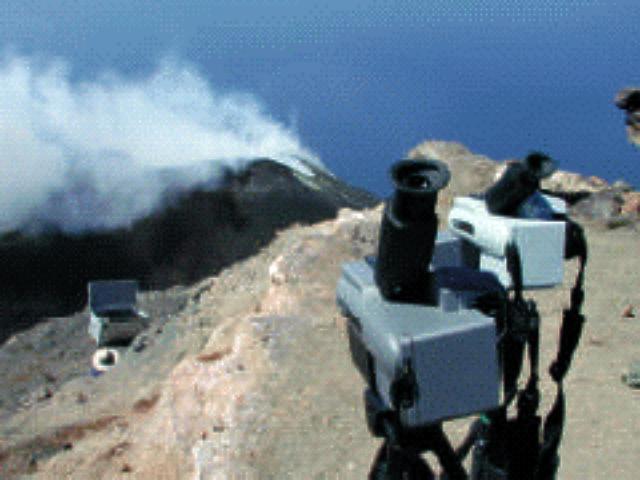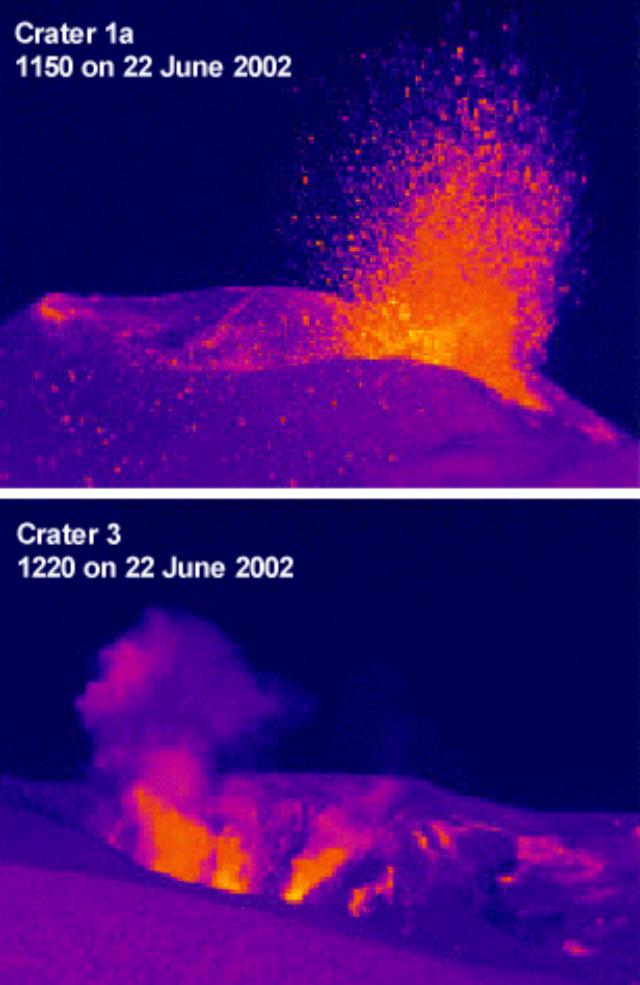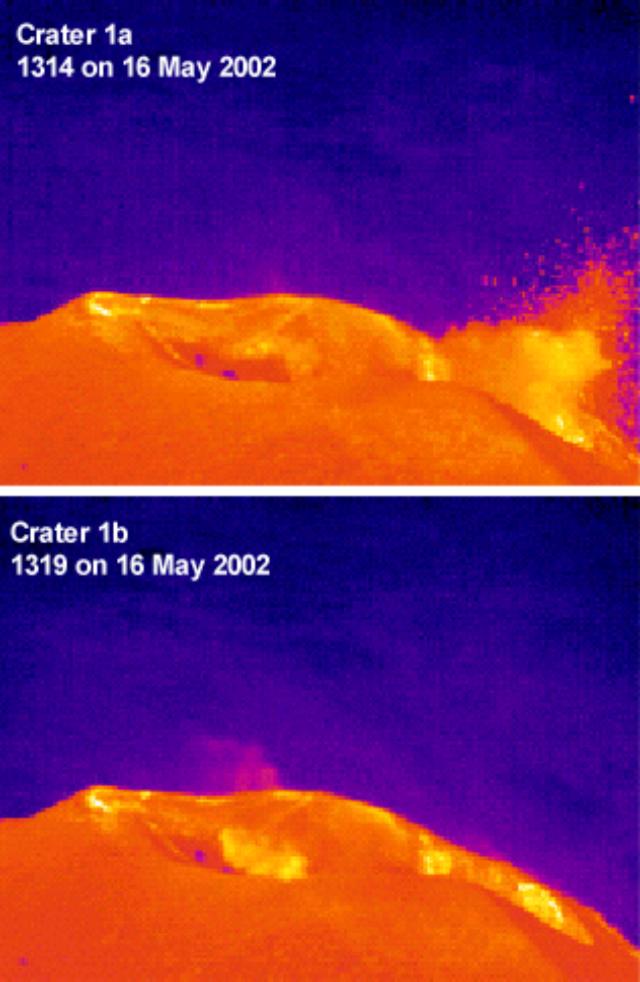Report on Stromboli (Italy) — July 2002
Bulletin of the Global Volcanism Network, vol. 27, no. 7 (July 2002)
Managing Editor: Richard Wunderman.
Stromboli (Italy) Increased activity beginning in June 2002 culminates in strong explosion on 24 July
Please cite this report as:
Global Volcanism Program, 2002. Report on Stromboli (Italy) (Wunderman, R., ed.). Bulletin of the Global Volcanism Network, 27:7. Smithsonian Institution. https://doi.org/10.5479/si.GVP.BGVN200207-211040
Stromboli
Italy
38.789°N, 15.213°E; summit elev. 924 m
All times are local (unless otherwise noted)
Except for the large explosion on 23 January 2002 (BGVN 27:01), activity at Stromboli was subdued until late June. However, activity fluctuated during 5-23 July (figure 68) and culminated with an explosion on the 24th. The explosion was observed (and photographed) from the harbor of the village of Stromboli by Boris Behncke and a group of French excursionists. Thermal camera and infrared spectrometer measurements were performed on 16 May and 22 June.
On 9 July, most activity was concentrated at several vents within the NE crater; the most vigorous vent was located farthest NE. Explosions sent bursts of incandescent bombs up to 150 m above this vent, with many directed obliquely toward the NE. The SW crater produced only a few weak explosions, while the central crater was inactive and remained so through 23 July.
On 17 July, the activity was much weaker; explosions occurred only at the most northeastern vent of the NE crater and produced jets of bombs that rose only a few tens of meters high. On 23 July the same vent produced incandescent jets up to 150 m high, some directed toward the Sciara del Fuoco, with spectacular cascades of bombs rolling toward the sea. Two smaller vents in the SW part of the NE crater were the site of smaller simultaneous explosions. Rather long-lived small explosions came from the SW crater and were often accompanied by ash plumes.
The explosion at about0745 on 24 July produced a brown, mushroom-shaped plume that rose ~500 m above the summit. The explosion occurred as a single burst followed by weaker ash emissions. While a loud detonation was heard in the village of Stromboli, no noise was noted at the village harbor. As a consequence of the explosion, light ash fell over the harbor area and on a number of nearby vessels. It is not known which crater produced the explosion and whether there were any persons present at the summit. Viewed from the neighboring island of Panarea during the evening of 24 July, the volcano continued its normal explosive activity with incandescent bursts at intervals of several tens of minutes.
Thermal camera and infrared spectrometer measurements by Instituto Nazionale di Geofisica e Vulcanologia (INGV). On 16 May and 22 June, a Fourier transform infrared (FTIR) spectrometer (figure 69) and FLIR thermal camera (figure 70) measurements of activity were performed on Crater 1 [NE Crater] and Crater 3 [SW Crater] from Pizzo Sopra la Fossa. Time, location, and estimates of intensity of periodic explosions were recorded.
 |
Figure 69. Photo showing the FTIR spectrometer instrument located at Pizzo Sopra la Fossa during measurements of Crater 1 in May and June 2002. Courtesy INGV. |
 |
Figure 70. Photo showing the FLIR thermal camera located at Pizzo Sopra la Fossa during measurements of Crater 1 in May and June 2002. Courtesy INGV. |
On 16 May, activity at the summit was primarily located at Crater 1 and consisted of relatively weak explosions containing smaller amounts of pyroclasts than had been seen in the preceding months. Examples of some explosions recorded with the FLIR are shown in figure 71.
On 22 June, FTIR and FLIR measurements were made from Pizzo Sopra la Fossa, observing all three craters. Measurements began at 1142 and concluded at 1350. Activity at the summit was primarily located at Crater 1 and consisted of explosions that propelled scoria to a maximum height of ~250 m above the craters. Occasional ash emissions were observed from Craters 1a and 3. The activity was of significantly greater intensity compared with that observed in May. Figure 72 shows the resulting images from measurements taken with the FLIR camera.
 |
Figure 72. FLIR images of Stromboli taken on 22 June 2002. Crater 1a at 1150 (top) and Crater 3 at 1220 (bottom). Temperature ranges vary with each image. Courtesy INGV. |
Geological Summary. Spectacular incandescent nighttime explosions at Stromboli have long attracted visitors to the "Lighthouse of the Mediterranean" in the NE Aeolian Islands. This volcano has lent its name to the frequent mild explosive activity that has characterized its eruptions throughout much of historical time. The small island is the emergent summit of a volcano that grew in two main eruptive cycles, the last of which formed the western portion of the island. The Neostromboli eruptive period took place between about 13,000 and 5,000 years ago. The active summit vents are located at the head of the Sciara del Fuoco, a prominent scarp that formed about 5,000 years ago due to a series of slope failures which extends to below sea level. The modern volcano has been constructed within this scarp, which funnels pyroclastic ejecta and lava flows to the NW. Essentially continuous mild Strombolian explosions, sometimes accompanied by lava flows, have been recorded for more than a millennium.
Information Contacts: Boris Behncke, Dipartimento di Scienze Geologiche, Universita di Catania, Corso Italia 55, 95129 Catania, Italy (URL: http://www.swisseduc.ch/stromboli/boris); Instituto Nazionale di Geofisica e Vulcanologia (INGV); Sezione di Catania (URL: http://www.ct.ingv.it/); Stromboli On-Line (URL: http://www.stromboli.net/).



